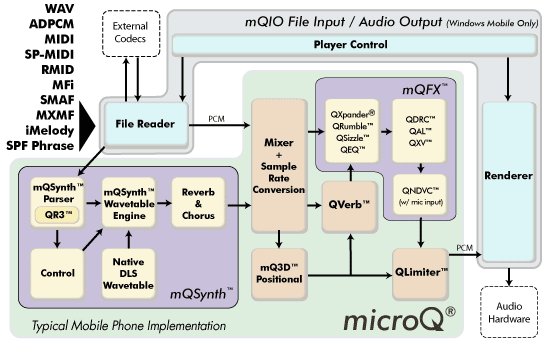 portable digital audio engine
The microQ®
Competitive Edge
portable digital audio engine
The microQ®
Competitive Edge- Industry leading solution,
ARM optimised - Proven track record and
established brand recognition - Replaces dedicated hardware
music synthesizer - Single-vendor audio solution:
- Simplifies integration
- Saves platform resources - Selectable, scalable modular
components for easy implementation - Small memory footprint
- High efficiency processing
- Supports earphones and speakers
- Tunable 3D for all narrow geometry speaker configs
microQ®
for Mobile Devices and Media Players

microQ is a compact, modular and highly efficient software digital audio engine for mobile devices enabling polyphonic ringtones, 3D game sound and enhanced music playback with multiple effects, as well noise reduction and echo cancellation for voice transmission.
microQ represents the culmination of over fifteen years of PC host and DSP audio software development and product deployment by QSound Labs, Inc., a world leader in sonic innovation.
Product Suite
Unmatched by any single vendor, microQ’s modular audio suite consists of the following major components:
mQSynth™ Polyphonic Wavetable Synthesizer
mQSynth plays polyphonic ringtone files, game music as well as interactive real-time sound events using digital wavetable instruments. mQSynth’s QSound Realtime Ringtone Remixer (QR3™) re-authors non-optimized content on the fly to produce consistent, distortion-free output.
mQ3D™ Positional 3D Audio Engine
mQ3D Positional places multiple sounds independently in 3D space for interactive gaming. Applicable to arbitrary streams or mQSynth synthesizer channels using native or custom instruments and sound effects. Optional: QEM® environmental modeling (reverberation).
mQFX™ Digital Effects
The mQFX suite enhances the music listening experience with:
QSound Spatial Enhancements
• QXpander® 3D stereo sound stage expansion.
• QVerb™ digital reverberation.
QSound Spectral Enhancements
• QEQualizer™ fully parametric spectrum control with presets.
• QSizzle™ dynamic high-frequency enhancement.
• QRumble™ dynamic low-frequency enhancement.
QSound Dynamix Controllers
• QAutoLeveler™ automatic gain control.
• QXtremeVolume™ handset speaker volume maximizer.
• QDRC™ dynamic range control.
• QLimiter™ anti-saturation dynamic range control.
• QNDVC™ noise dependent volume control. NEW!
mQFX is also available as a separate package. For more details see mQFX page.

Platforms & Implementations
microQ is written in highly-optimized C++ using fixed-point math, featuring the combination of small footprint and high efficiency that is the hallmark of QSound audio platforms. An optional C interface is also available.
Modular, scalable components make microQ readily adaptable to any target environment, with the requirement for platform-specific code reduced to input and output interfaces.
microQ is currently available for DSP and RISC architectures running Linux, Symbian OS®, Nokia® Series 60, and Microsoft® Windows Mobile.
- ARM7™/ARM9™/ARM11™/ARM Cortex™+ Neon™ processor families (Optimized by ARM®)
- CEVA-Teak™ and Teak Lite™ DSP cores
- Qualcomm® MSM 6xxx / MSM 7xxx
- Marvell® PXA300 / PXA310
- Tensilica® Xtensa®
- AMD Imageon™
- Infineon MP-E
- TI® OMAP™
microQ can be implemented at various system levels, e.g. within a driver, as a plug-in, or as a user application. microQ can be provided in the form of object code, or custom ported by QSound Labs to suit your specifications.
Support for APIs & Standard Formats
microQ renders polyphonic sequenced content (MIDI, SP-MIDI, MXMF, iMelody, MFi v4.0, SMAF-MA2/MA3/MA5 with LED, Vibration and .SPF Phrases) with its native wavetable synthesizer sample set or using custom downloadable instruments (DLS, DLS 2.0, Mobile DLS).
microQ plays multiple linear and compressed digital audio formats (WAV, PCM, ADPCM).
microQ API support: Vodafone® VFX, JSR-135, JSR-234, OpenSL ES.

